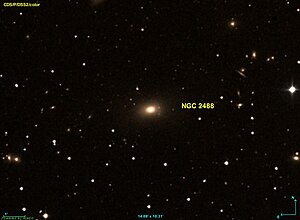NGC 2488
| Galaxy NGC 2488 |
|
|---|---|

|
|
| AladinLite | |
| Constellation | lynx |
|
Position equinox : J2000.0 , epoch : J2000.0 |
|
| Right ascension | 08 h 01 m 46.0 s |
| declination | + 56 ° 33 ′ 14 ″ |
| Appearance | |
| Morphological type | S0- |
| Brightness (visual) | 12.6 mag |
| Brightness (B-band) | 13.6 mag |
| Angular expansion | 1.4 ′ × 0.8 ′ |
| Position angle | 100 ° |
| Surface brightness | 12.8 mag / arcmin² |
| Physical data | |
| Redshift | 0.029107 ± 0.000150 |
| Radial velocity | (8726 ± 45) km / s |
|
Stroke distance v rad / H 0 |
(393 ± 27) · 10 6 ly (120.4 ± 8.4) Mpc |
| history | |
| discovery | Wilhelm Herschel |
| Discovery date | March 18, 1790 |
| Catalog names | |
| NGC 2488 • UGC 4161 • PGC 22520 • CGCG 287-029 • MCG + 09-13-109 • 2MASX J08014590 + 5633120 • GC 1600 • H III 837 • h 475 • | |
NGC 2488 is a lenticular galaxy of the Hubble type E-S0 in the constellation Lynx in the northern sky . It is estimated to be 393 million light years from the Milky Way .
The object was discovered by Wilhelm Herschel on March 18, 1790 .
